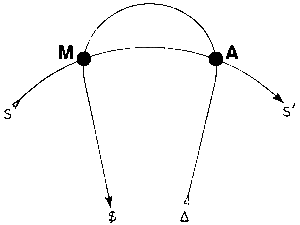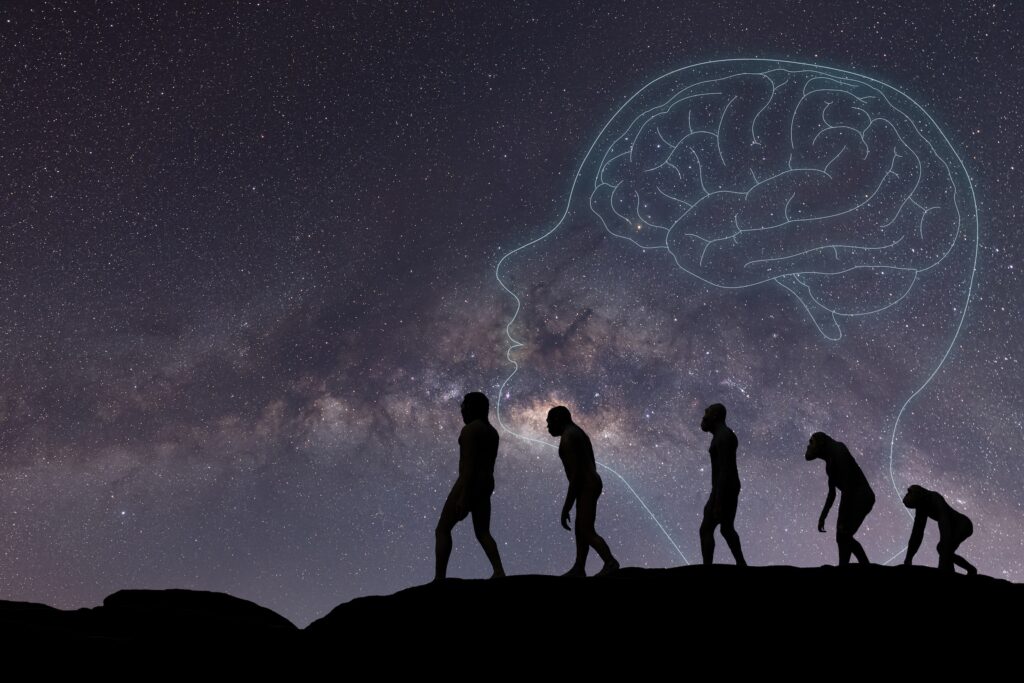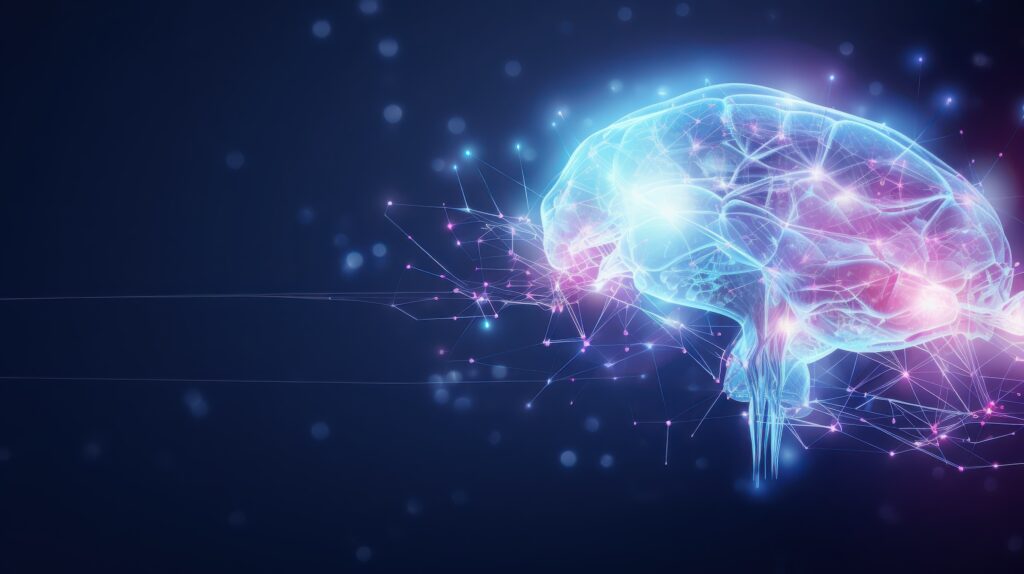Metabolism is what the ‘unconscious’ mind looks like
Reading | Philosophy
![]() Dr. Ludwig Sachs | 2024-02-04
Dr. Ludwig Sachs | 2024-02-04

Dr. Sachs discusses the dynamics of our deepest, seemingly ‘unconscious’ mental processes, and shows remarkable correspondences between them and metabolic processes such as protein synthesis and folding. He suggests, along firm idealist lines, that our body’s metabolism is simply a metaphor, the extrinsic appearance of our inner, ‘unconscious’ mental processes. In other words, metabolism may be what the deepest layers of our own mind look like, when displayed on the screen of perception. This is an involved essay and not the easiest of reads, but it is well worth the effort.
From the idealist point of view—which entails a psychic or spiritual foundation of being—a fascinating puzzle arises: how do the myriad aspects of our world, from human consciousness and matter to time, space, and life, originate from this foundation?
In a previous article1, I already discussed the three orders of structural psychoanalysis (the Imaginary, Symbolic, and Real), a development of Freud’s conception of the psychic apparatus by the French psychiatrist Jacques Lacan2. I further discussed how the dissociation or splitting of the subject leads to a lack of being, as well as how the subject repeatedly tries in vain to find itself. In the language of systems theory, these repeated attempts to ‘return to oneself’ are self-referential processes. I already pointed out the phenomena of complex systems that arise through self-referentiality in connection with the language-like structures of the Symbolic, as well as its iterative referential structure: fractal geometries characterized by self-similar patterns that we can find everywhere in nature.
The concept of self-similarity could potentially be a key to understanding deeper connections in our reality. When we apply this principle to mental and physical processes, an exciting question arises: is there a self-similar relationship between the unconscious processes that govern our mental life and the genetic mechanisms that regulate our bodily functions? This consideration leads us to a deeper examination of structural psychoanalysis and biological processes.
Before we proceed, it is extremely important to emphasize that the ‘subject’ discussed here is not understood as a human individual in the everyday sense. As I outlined in the previous article, our everyday consciousness is predominantly under an Imaginary perspective, entailing that the world presents itself to us from the dissociated perspective of an imaginary ‘I.’ However, we overlook the linkage with the Symbolic and Real orders as a split subject.
Therefore, when I speak of the subject in the present essay, it is in the sense of an archetypal Anthropos, Schelling’s ‘World Spirit,’ which unfolds in time and space and manifests itself in the diversity of all living things—not only as a human. The considerations refer to the topological structures of this subject in the Real, Symbolic, and Imaginary orders.
The chain of signifiers
In the context of structural psychoanalysis, the concept of the ‘chain of signifiers’ is central to understanding the Symbolic and the language-like structures of the unconscious. This chain is best visualized by considering everyday signifiers that we regularly and consciously deal with: sounds, words, sentences. These elements of language are connected in a temporal sequence, known as diachronic chaining.
The meaning of a statement—the signified—emerges from the linking of these signifiers in their specific order. A change in this order can considerably alter the meaning, as illustrated by the statement ‘Idealism is better than Materialism,’ when compared to ‘Materialism is better than Idealism.’
However, the chain of signifiers is not limited to a horizontal, diachronic (temporal) chaining. At each point in this chain, one can imagine a vertical, synchronic chain or ‘plane’ that adds further levels of meaning. This vertical linking of signifiers is understood in structural psychoanalysis as metaphor, as opposed to horizontal metonymy. Here, it is emphasized that meanings always refer to other meanings and never directly to ‘the thing itself.’ The combination of signifiers creates a kind of barrier that prevents direct access to the signified, or the meaning. An analogy for this is the experience of looking up the meaning of a word in a dictionary: one is often led from one term to the next, never reaching a final clarification.
Therefore, the generation of meaning in a chain of signifiers is a dynamic process in which the signified changes with every added element—the signified ‘slides under the signifiers,’ so to speak. In structural psychoanalysis, the meaning (the signified) of a sentence is determined not solely by the individual signifiers (words), but significantly by their overall sequence. An important phenomenon in this context is the retroactive determination of the signified of a chain of signifiers, highlighting how the meaning of a sentence is fixed by the end of the chain.
Consider this example: the sentence ‘I love you’ conveys a very different meaning than ‘I do not love you.’ This illustrates how each added signifier changes the overall meaning of a sentence. Also, ‘I do not love you’ suggests a different context than ‘I do not love you anymore.’ And this, in turn, changes once again if ‘as much as her’ is added, to form ‘I do not love you as much as her anymore.’ In this case, the words ‘as her’ retroactively influence and fix the meaning of the entire sentence.
The quilting point
This dynamic of meaning formation can be topologically represented by the concept of the ‘point de capiton,’ or quilting point, a concept derived from Ferdinand de Saussure’s Course in General Linguistics. Saussure’s model assumes that the signifier and signified correspond point by point and together form a ‘sign,’ an assumption critiqued by structural psychoanalysis. It emphasizes that the signified of a sentence is its overall meaning, which does not simply result from the addition of the meanings of individual words but is retroactively fixed by the end of the chain. The quilting point in this context represents the function of specific signifiers (so-called ‘master signifiers’), which intervene in the chaotic signified, fixing and simultaneously altering it.
The signified: The desire modified by the signifier
In the context of structural psychoanalysis, the signified is viewed as a form of human want that is influenced and transformed by the signifier. This transformation of need by the signifier is referred to as ‘desire.’ However, desire is not to be understood solely in biological or physiological terms: it is structured by the signifier and thus acquires a special dynamic.
The desires are not only transformed by the signifier, but their transformation is also associated with a loss—structurally speaking, a lack. The entirety of the effects of the signified produced by the signifier is this lack. Thus, the imprinting of the signifier into the subject leads to the emergence of the signified, which can also be understood as a lack and is associated with the dissociation/splitting of the subject, as I discussed in my previous article.
Therefore, the signified in its entirety is not only the result of the effect of the signifier, but also an expression of the lack and the dissociation/splitting of the subject that arises from this effect.
The graph of desire
In structural psychoanalysis, the ‘graph of desire’3 (see below) is used to illustrate the concept of the quilting point and the relationships between signifiers and signifieds. This graphical representation includes two main lines forming an arc, each representing different aspects of language. The line running from S (linguistic sign) to S’ (linguistic meaning) symbolizes the chain of signifiers—i.e., the sequence of words and sentences we use in everyday life on a conscious, Imaginary level. This is called the ‘signifying chain.’ The other line, from Δ (the pre-linguistic subject) to $ (the barred subject) and forming a horseshoe shape, represents the chain of signifieds—i.e., what is generated in terms of meaning and sense by the signifiers. This second line is called the ‘vector of desire.’
In different words, the vector of desire represents subjective intentions arising from needs, the deliberate pursuit of the fulfillment of these needs. The signifying chain, in turn, represents sentences such as ‘Give me something to eat!’ Need and speech are linked by the two intersection points, symbolizing the interaction between signifiers and signifieds.

The first intersection point on the right is labeled ‘A’ for the French ‘Autre’ (‘Other’). It stands for the language code and vocabulary used by the subject. The capitalization indicates that it pertains to the Symbolic order. The interaction at this point shows how the vocabulary imprints itself in the subject and alters its intentions, influencing its need structures. Desire is thus heavily dependent on the relationship to the Other. ‘Desire is the desire of the Other’ is the formula of structural psychoanalysis for this entanglement. It primarily refers not to being desired by the Other, but desiring as the Other. What we think of as our own desires often consist of the wishes and messages of parents, grandparents, great-grandparents, etc., most of which are unconscious.
Therefore, to be satisfied, the need must pass through the grid of language. It must be expressed in claims or symbolically articulated demands. To be understood, these claims must be expressed in a predetermined code.
The left intersection point is labeled ‘M’ for ‘message’: communication, message, news. Like the chains of signifiers on the conscious level, those of the unconscious also have a message, a meaning, a signified. The aim of psychoanalytic practice is to bring to light the messages of the unconscious: the meaning of dreams, symptoms, parapraxes, etc.
The graph represents how need is captured by language and how this, in turn, is connected to the formation of the ‘I.’ This ‘I’ ideal is not only made up of signifiers, but is also a modification of the drive structure, since it acts back on the need. The symbol $—a crossed-out S—stands for the subject shaped by language and therefore excluded from the unconscious, the seat of desire.
This is to remind us that needs have always already passed through these stations and been shaped by language; that the assumption of a whole, unsplit subject as the bearer of a pre-linguistic need is thus a mythical construction based on the desire for imaginary wholeness. As discussed in the previous article, the split is constitutive for the subject. It is what makes the subject possible.
The master signifier
The I(-ideal) must be seen in connection with what structural psychoanalysis refers to as the ‘master signifier’: a signifier that seems to have an absolute meaning, but in an illusory way. For instance, the ‘I’—with which the speaker refers to themselves—is a master signifier. It forms the basis of the myth of the ideal I. In this myth, the I appears as an entity that is identical to itself. Self-identity—the absoluteness of meaning—is thus illusory because signifiers only function differentially. The master signifier, therefore, relies on an illusory blocking of the differential nature of the signifier. And since meaning is based on the difference of signifiers, the master signifier is without meaning.
Master signifiers are about identification; more precisely, a certain form of identification: the one whose result is called the I-ideal. When one seeks to clarify the meaning of a signifier, one is referred from signifier to signifier, and thus the meaning shifts anew. So how can it be that spoken words are still understandable? This is the function of the aforementioned master signifiers. They have no meaning themselves and are limited to the function of bringing the movement of referring from meaning to meaning to a halt. In this way, they sort of sew the signifiers with the signifieds. Signifiers that realize this stop function are the master signifiers or quilting points (as above) of structural psychoanalysis: they prevent the signified from constantly slipping under the signifier.
If one focuses on the functioning of sentences, the meaning—which shifts with every added word—is stabilized by the end of the sentence; the signifier in quilting-point function is, in a sense, the period.
The phantasm
Another important aspect in this context is the concept of the phantasm, already described in the previous article. The phantasm allows the subject to locate itself in the context of its desires. In the phantasm, the split subject ($) relates to an object in which it projects what it has lost by entering the world of language. The subject, attempting to grasp itself in its desire, can initially only grasp itself in what it desires. And here, again, the I or I-ideal at the end of the vector of desire plays a central role, as it causes the split subject to locate itself as an object and to fix itself in an illusory manner.
Self-similarity in biology and psychoanalysis: Discoveries at the intersection of protein biosynthesis and the unconscious
Protein biosynthesis—a central biological process in which proteins are synthesized from amino acids according to the template of genetic information in DNA and RNA—is surprisingly analogous the concepts of the unconscious in structural psychoanalysis.
At the heart of protein biosynthesis is messenger RNA (mRNA), which acts as a messenger transporting genetic information from the DNA code in the cell nucleus to the ribosomes, the sites of protein production. There, the sequence of the mRNA is translated into a specific amino acid chain that folds into a functional protein. This process involves several steps: transcription, translation, and folding. The mRNA plays a key role by translating the ‘language’ of DNA into a form that can be ‘read’ by the ribosomes and translated into proteins via tRNA.
The attentive reader will have already noticed the similarity here. The processes of the unconscious are conveyed to us (as a dissociated ‘part’ of the split subject) in a parable-like manner in the form of protein biosynthesis. Put in different words, the processes of the unconscious appear to us as protein biosynthesis from a dissociated (imaginary spatiotemporal) perspective.
The words and sentences in the signifying chain (S to S’ in the graph of desire above) can be easily identified with the molecular chain in messenger RNA, the element that transmits the genetic message. Thus, from a topological perspective, mRNA may correspond to a chain of signifiers in the unconscious. If this is the case, one would expect that the synthesized protein emerges from the vector of desire; that the signified corresponds to the protein.
The embodiment of the subject—the biological organism—is shaped by proteins. From the perspective of structural psychoanalysis, the subject is split, dissociated, or excluded, which is represented by $ in the graph of desire. The crossing out of the S symbolizes that the subject is marked by the signifiers. This marking results in the subject being excluded from a part of itself, a part that constitutes it and is referred to as the unconscious.
Such a split is also reflected in our body, which is ‘marked’—among other things—by the language of DNA: processes within our body that are not directly accessible to us. As such, we are also physically ‘split’ between the part to which we have access (our Imaginary body surface) and the inner part from which we are both psychologically and physically excluded because we are ‘barred outside.’
The ribosomal quilting point
As discussed, in the graph of desire two intersection points arise between the signifying chain and the vector of desire, which we labeled as ‘A’ for Other and ‘M’ for Message. This means that the satisfaction of need is subjected to a code in language (A) and tied to the formation of a message (M). Let’s compare this with the processes at the ribosome.
At the so-called A-site of the ribosome, the tRNA loaded with an amino acid binds—through its anticodon—to the corresponding codon of the mRNA. What does this so-called codon recognition represent? Or, in J. W. v. Goethe’s words, how does it present itself to the “contemplative power of judgment”? For the process of protein biosynthesis to make sense, it must submit to the rules of a code. This submission takes place at the A-site of the ribosome, which we can therefore topologically align with the intersection point A of the graph of desire.
At the intersection point ‘M’ of the graph of desire, the signified is formed. Where can we locate this in the ribosome? As already discussed, the signified corresponds to the synthesized protein. The site of this synthesis, where the elongating protein emerges, is the P-site. Thus, we find the two topological intersection points in a self-similar manner at the corresponding positions in the ribosome.
Another connection is equally clear: we mentioned the so-called master signifiers, which are necessary to finalize the stitching of the chain of signifiers (in this case, the mRNA) with the signified (the protein biosynthesis) in the form of a quilting point. These master signifiers have no meaning themselves. They are limited to the function of bringing the movement of referring from meaning to meaning to a halt. Now, what brings the translation—the reference movements of the ribosome from which the protein (the meaning, the signified) emerges—to a halt? The so-called stop codon! And for this stop codon—also called ‘non-sense (!) codon’—there is no corresponding tRNA, so it remains empty; it has no meaning itself, just as the master signifier itself has no meaning.
From the perspective of the quilting point, the role of the tRNAs, which represent adaptors in the sense of code biology4—i.e., those molecules that establish a relationship between two different types of molecules—also becomes clear: the adaptors (the tRNAs) execute the quilting point by sewing the signifiers with the signified. It’s probably no coincidence that the structure of this ‘quilting point tRNA’ is referred to as a hairpin structure: the needle with which the quilting point is executed.
The Levinthal Paradox
In connection with the quilting point, there is another remarkable analogy: the so-called Levinthal Paradox. The molecular biologist Cyrus Levinthal came upon this paradox while elucidating the process by which a chain of amino acids quickly achieves its folded state as a protein. The paradox is that the combinatorial multitude of possible foldings increases exponentially with the length of the amino acid chain and should require immense time. Yet, protein folding happens rather quickly in the body.
Can we better understand this paradox with the help of the self-similar structures of the unconscious? We have already discussed the retroactive determination of the signified of a chain of signifiers by the end of the chain: the signifier also intervenes in the signified on the diachronic level—i.e., in the temporal succession of the chain of signifiers. Here, the last element of a chain—somewhat like the period in a sentence—retroactively determines the meaning of the entire sentence. There is a feedback loop from the last element of the chain to the signified of the entire chain.
Protein biosynthesis similarly involves the creation of a signified, which is precisely brought into its overall desired form—i.e., folded configuration—by the last element of the chain of signifiers, just as the meaning of a sentence is retroactively determined by its end.
Hidden messages: the unconscious as the discourse of the Other in psychoanalysis and biology
In structural psychoanalysis, the unconscious is understood as the ‘discourse of the Other.’ This means that the unconscious is more than just a collection of signifiers; it is an ongoing discourse, a form of communication consisting of prohibitions, instructions, and rules. The author of these messages is not the subject itself, but the ‘Other’ in its symbolic function. This ‘Other’ represents the Symbolic order that sets limits for the subject.
The subject must persistently repeat the misunderstood part of the discourse of the Other, which is inherently fraught with lack, manifesting in symptoms and transferences. The unconscious manifests itself in this repetition, in the symptoms and transferences.
Similarly, our bodies, our cells, speak within us persistently, without our consciousness. In constant repetition, organisms emerge from their ancestors and their genetic messages, to reproduce and carry forward the messages. These consist of misunderstood codes, of rulebooks, of prohibitions and commands. And these messages act within us, whether we want them to or not. They speak incessantly and are exchanged in a network of organisms.
We do not understand this language, these messages; they are not conscious to us. And because we do not understand them, we are forced to repeat them constantly. In doing so, we produce symptoms. One of these ‘symptoms’ is our body, which also speaks without our understanding the messages.
Therefore, embodied organisms themselves can be understood as quilting points, as repeated attempts of the subject to sew itself together, to find itself as a self, and finally come to a halt. In this process, new signifieds, meanings, proteins, organisms continually emerge, seen from an Imaginary perspective as an evolutionary process in time and space, from plants to animals and up to the human ‘I.’
References
- https://www.essentiafoundation.org/the-subject-beyond-the-i-on-structural-psychoanalysis/reading/
- https://www.lacanonline.com/ or https://lacan-entziffern.de/ (German)
- https://www.lacanonline.com/2020/04/a-tour-of-the-graph-of-desire/
- Barbieri M. What is code biology? Biosystems. 2018 Feb;164:1-10. doi: 10.1016/j.biosystems.2017.10.005. Epub 2017 Oct 6. PMID: 28993248.

Essentia Foundation communicates, in an accessible but rigorous manner, the latest results in science and philosophy that point to the mental nature of reality. We are committed to strict, academic-level curation of the material we publish.
Recently published
Reading
Essays
Seeing
Videos
Let us build the future of our culture together
Essentia Foundation is a registered non-profit committed to making its content as accessible as possible. Therefore, we depend on contributions from people like you to continue to do our work. There are many ways to contribute.















